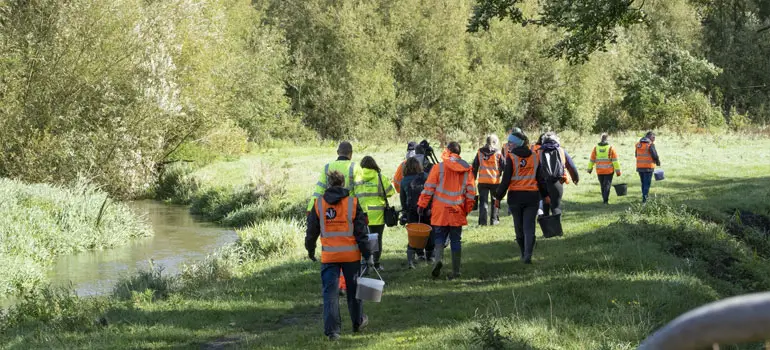A collective of dedicated volunteers has significantly advanced the £4.1 million Stafford Brooks biodiversity initiative, fostering wildlife and nature within the town.
Extensive conservation efforts have been spearheaded by Staffordshire Wildlife Trust, targeting grasslands and areas alongside the River Sow. This includes the creation of new pools and wildflower meadows. However, the subsequent phase necessitates manual labour rather than heavy machinery, prompting volunteers from National Highways to offer their assistance.
The extensive conservation project is being funded by National Highways through its Designated Funds programme, in collaboration with Staffordshire Wildlife Trust, Stafford Borough Council, and the Environment Agency. These combined efforts are concentrated on enhancing eight vital sites within the borough. The initiative includes transforming grasslands into wildflower meadows, upgrading urban floodplains, and reprofiling rivers to support improved habitats. As part of this endeavour, heavy machinery has reshaped the landscape, forming shallow riverbanks to slow water flow and establishing 21 new wetland ponds.
Active conservation work is occurring at Kingsmead Marsh, Kingston Pool Covert (South), Rising Brook, Radford Meadows, Queensville, Riverside, Littleworth Former Tennis Courts, and Corporation Street Former Bowling Green. The forthcoming phase aims to improve grasslands at smaller locations, such as Riverside, the former tennis courts, and the old bowling green. Given the proximity of these sites to residential areas, the approach requires small equipment, hand tools, and volunteer labour to distribute locally sourced wildflower seeds.
Recently, a group of roughly twelve volunteers joined regular conservationists in sowing wildflower seeds onto prepared areas, poised to transform into vibrant meadows. Paul Unwin, National Highways Regional Sponsor, remarked, “We are delighted with the progress that is being made and the conservation work that has already taken place. But when we heard about the need for some more manpower, we had a rush of volunteers, happy to give up their time to help. It was a pleasure to be involved in sowing the seeds for a stunning landscape that will offer a fantastic habitat for wildlife as well as being a beauty spot that local people can enjoy for years to come. We know the environment can sometimes be impacted by previous roadbuilding and we are committed to giving back to the communities that live near our roads and making a real difference to the environment.”
David Cadman, Head of Nature Recovery Networks for Staffordshire Wildlife Trust, stated: “We’re thrilled to have National Highways join us today to see first-hand what their funding has allowed us to achieve and take part in practical conservation. The lowland wildflowers we plant today are found in floodplains and will boost the biodiversity of this local nature reserve. It is one piece of the puzzle with other sites in the project, creating healthier habitat for wildlife across the wider Nature Recovery Network in Stafford.”
Vicki Liu, Catchment Coordinator at the Environment Agency, added: “The Stafford Brooks project is an exciting nature recovery project that is providing higher quality, more diverse and better-connected habitats along the watercourses across Stafford. The project will help local rivers and the wildlife that use them by improving the connections both along river corridors and between the rivers and their floodplains. In suitable places, the rivers will be encouraged to make more use of their floodplains, helping to create diverse floodplain habitats, which can have knock-on improvements for biodiversity, water management and local water quality.”
The combined efforts of volunteers and organisations are essential to the success of the Stafford Brooks biodiversity scheme. This initiative promises to enhance habitats, promote biodiversity, and offer lasting natural benefits to the community.

